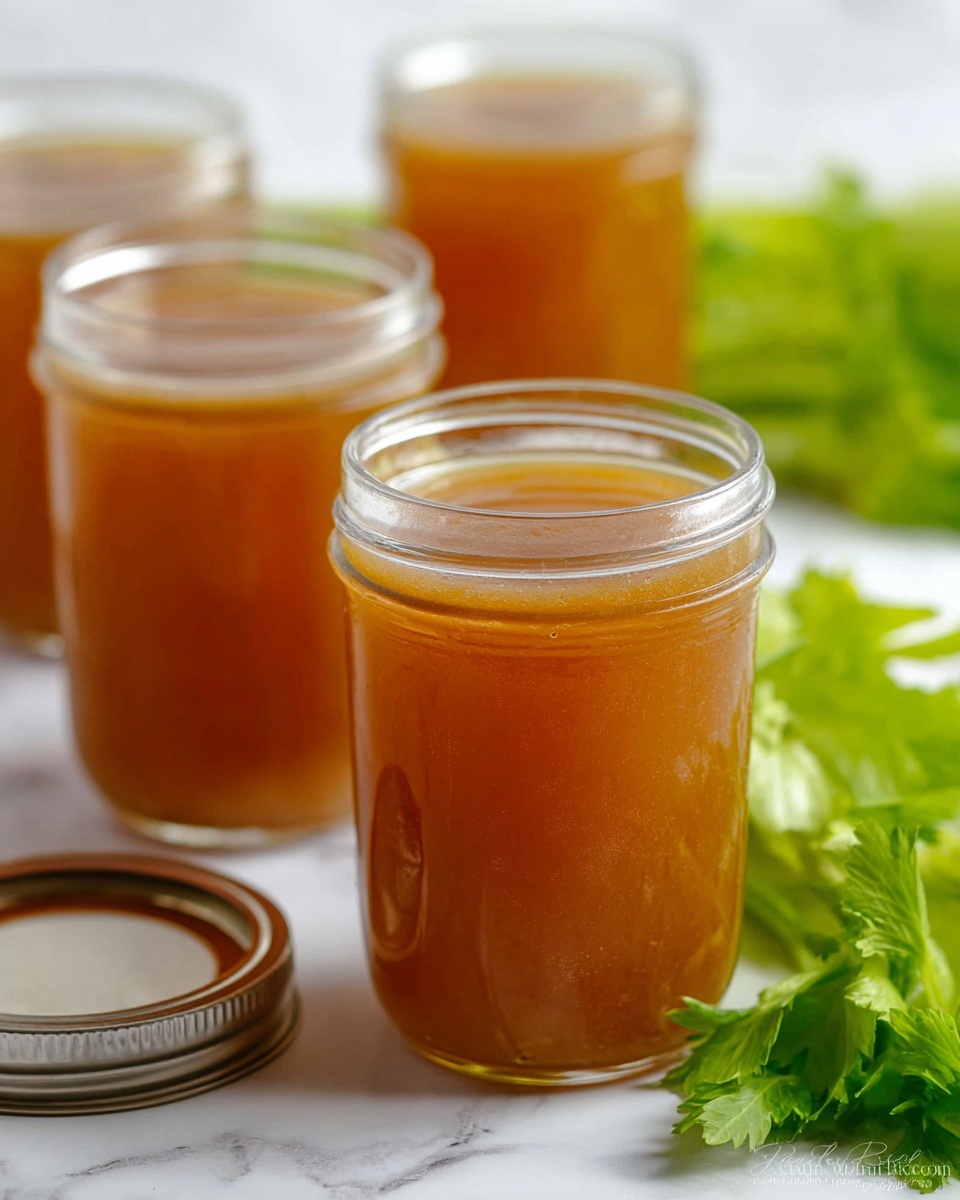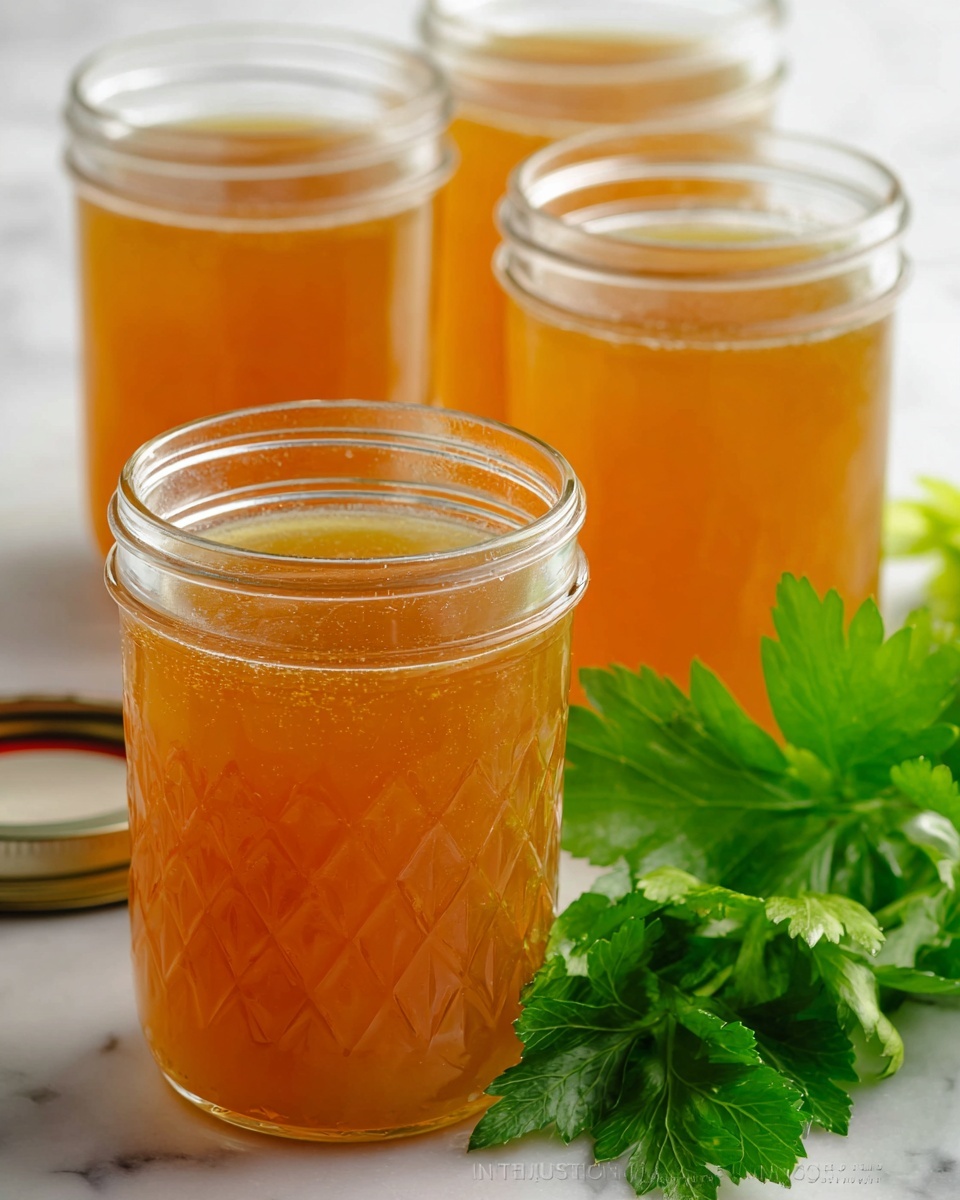There is something truly soul-soothing about a rich, fragrant beef broth simmered to perfection. This Homemade Beef Stock Recipe transforms simple ingredients like meaty bones, vegetables, and aromatics into a golden elixir that serves as the backbone for countless dishes. Whether you’re aiming to elevate your soups, stews, or sauces, making your own beef stock at home unlocks layers of depth and warmth that store-bought versions simply can’t match. Trust me, once you experience the magic of homemade stock, you’ll never want to go back.

Ingredients You’ll Need
Gathering a handful of straightforward ingredients is all it takes to craft this deeply flavorful stock. Each ingredient plays a starring role, from the robust beef bones that build body and richness, to the fresh vegetables that lend natural sweetness and color.
- 4 lbs meaty beef bones: Choose bones with a good amount of marrow and connective tissue to create a gelatin-rich stock that’s lush and silky.
- 2 Tbsp olive oil: A quick roast in olive oil helps develop a lovely caramelized flavor base for your stock.
- 1 large yellow onion (quartered): Onions add aromatic sweetness and deepen the savory notes.
- 2 celery ribs (cut into thirds, leaves attached): Celery brings a subtle earthiness and bright herbal lift.
- 2 carrots (peeled & cut into 1-2” chunks): Their natural sugars enhance the stock’s sweetness and color.
- 3 garlic cloves (peeled): Garlic infuses gentle warmth and complexity throughout the broth.
- 1 Tbsp cider vinegar: This helps extract minerals and flavor from the bones, boosting the stock’s richness.
- 1 tsp salt (optional): Adds subtle seasoning—best to adjust after cooking to taste.
- 1 bay leaf (optional but nice): Provides a subtle herbal depth without overpowering the flavor.
- 10 peppercorns: Light spice and aromatic pop elevate the overall profile beautifully.
- Filtered Water: Quantity varies based on your cooking method, ensuring your pot or slow cooker is just right.
How to Make Homemade Beef Stock Recipe
Step 1: Roast the Bones and Vegetables
Start by preheating your oven to 450°F (230°C). Toss the beef bones with olive oil and spread them out on a large roasting pan. Add the quartered onion, celery, and carrots around the bones. Roast everything for about 30–40 minutes until nicely browned, turning once midway. This roasting step intensifies the flavors and adds a beautiful nutty undertone to the stock.
Step 2: Transfer to Stock Pot and Add Aromatics
Once roasted, move the bones and vegetables into a large stockpot. Add garlic cloves, cider vinegar, salt, bay leaf, and peppercorns. The cider vinegar is key—it helps break down the collagen in the bones, resulting in that signature silky texture.
Step 3: Add Filtered Water and Simmer
Pour filtered water over the bones and vegetables until submerged according to your cooking vessel’s capacity. Slowly bring the pot to a gentle simmer over medium heat. Once simmering, reduce the heat and keep it low — you want just the occasional bubble breaking the surface. Let the stock gently cook for about 2 hours, uncovered, to reduce and concentrate all those deep flavors.
Step 4: Skim and Strain
Every 30 minutes or so, skim any foam or impurities that rise to the surface using a ladle or skimmer. This step keeps your stock bright and clear. When the simmering time is up, carefully strain the stock through a fine mesh sieve or cheesecloth into a clean container. Discard the solids — the bones have given all their goodness to make your beloved homemade beef stock.
How to Serve Homemade Beef Stock Recipe

Garnishes
A hot bowl of beef stock is delightful on its own, but adding fresh garnishes can take it to the next level. A sprinkle of chopped parsley or thyme adds herbal freshness, while a crack of black pepper brings subtle heat. If you want a bit more texture, toasted croutons or a dollop of sour cream can be wonderful accompaniments.
Side Dishes
This homemade beef stock makes a perfect warm-up before heartier meals or pairs beautifully alongside rustic bread, roasted vegetables, or a cozy beef stew. The depth of flavor complements dishes with beef or root vegetables especially well.
Creative Ways to Present
Beyond soup, use your stock as a base for risottos, gravies, or braises to impart an extra layer of richness. Freeze it in ice cube trays for easy seasoning of sauces or stews. For a gourmet touch, try infusing it with dried mushrooms or fresh herbs when reheating to customize flavors for different recipes.
Make Ahead and Storage
Storing Leftovers
If you don’t use all your homemade beef stock immediately, simply cool it completely, then transfer to airtight containers. Stored in the refrigerator, it will keep beautifully for up to five days, making it perfect for batch cooking.
Freezing
For longer storage, freezing your stock is a lifesaver. Pour stock into freezer-safe containers or bags, leaving space for expansion. Frozen, it maintains its rich flavor and gelatinous texture for up to six months. Thaw in the refrigerator overnight before use.
Reheating
When reheating your homemade beef stock, do so gently over low heat to preserve its silky consistency. Stir occasionally and avoid boiling to keep the delicate flavors intact. Once warmed, taste and adjust seasoning if needed before serving or incorporating into recipes.
FAQs
Can I use raw bones instead of roasting them?
While you can technically start with raw bones, roasting them first develops much more complex and rich flavors through caramelization. Roasting is highly recommended to get the best depth in your stock.
Is it necessary to add vinegar? What does it do?
The cider vinegar helps draw nutrients, especially minerals like calcium, out of the bones during simmering. It enhances the gelatin and richness of the stock, contributing to a fuller mouthfeel and better nutrition.
Can I add other herbs or spices?
Absolutely! Classic herbs like thyme, rosemary, or even parsley stems can add wonderful complexity. Just be cautious not to overpower the natural beef flavor—add extras in moderation.
Why is the stock sometimes cloudy, and how can I avoid that?
A cloudy stock usually means it was boiled too vigorously or not skimmed enough. Keeping a gentle simmer and regularly skimming off foam ensures your stock stays clear and beautiful.
How long can I keep homemade beef stock in the fridge?
Properly stored in an airtight container, your stock will keep fresh in the refrigerator for about five days. If you need to store it longer, freezing is the best option.
Final Thoughts
Making this Homemade Beef Stock Recipe is such a rewarding kitchen ritual that fills your home with irresistible aromas and results in a deeply nourishing base for countless meals. Whether you’re a seasoned chef or just beginning to explore homemade flavors, this stock will become a beloved staple in your cooking repertoire. So roll up your sleeves and give it a go—you’ll be amazed at how much love and flavor this simple process adds to your dishes!
Print
Homemade Beef Stock Recipe
- Prep Time: 5 minutes
- Cook Time: 120 minutes (varies depending on method, up to 8-12 hours for slow cooker)
- Total Time: 2 hours 5 minutes to 12 hours 5 minutes
- Yield: Approximately 12 cups
- Category: Soup/Broth
- Method: Simmering
- Cuisine: American
Description
This Homemade Beef Stock recipe is a rich and flavorful base perfect for soups, stews, and sauces. Made by simmering meaty beef bones with vegetables and aromatics, it captures deep, hearty flavors without any additives. Using simple ingredients like onion, celery, carrots, garlic, cider vinegar, and whole spices, this stock forms a nutrient-dense foundation for countless recipes.
Ingredients
Beef Bones
- 4 lbs meaty beef bones*
Vegetables & Aromatics
- 1 large yellow onion (quartered)
- 2 celery ribs (cut into thirds, leaves attached)
- 2 carrots (peeled & cut into 1–2” chunks)
- 3 garlic cloves (peeled)
Seasonings & Others
- 2 Tbsp olive oil
- 1 Tbsp cider vinegar
- 1 tsp salt (optional)
- 1 bay leaf (optional)
- 10 peppercorns
- Filtered water (quantity varies by cooking vessel: Stock Pot: 16 cups, 6 Quart Slow Cooker: 12 cups, Instant Pot: 10–12 cups)
Instructions
- Prepare the Bones: Preheat your oven to 450°F (232°C). Place the meaty beef bones on a roasting pan and roast for about 30-45 minutes, turning occasionally, until they develop a deep brown color. This step enhances the flavor of your stock by adding a rich, caramelized depth.
- Sauté the Vegetables: In a large stockpot or slow cooker, heat 2 tablespoons of olive oil over medium heat. Add the quartered onion, celery ribs, carrots, and peeled garlic cloves. Cook for 5-7 minutes until the vegetables soften and develop a bit of color, which enhances their flavor.
- Combine Ingredients: Transfer the roasted bones to the pot with the sautéed vegetables. Add 1 tablespoon of cider vinegar, which helps draw nutrients like collagen from the bones into the stock. Pour in filtered water to cover the bones and vegetables—approximately 16 cups for a stockpot, 12 cups for a 6-quart slow cooker, or 10-12 cups for an instant pot.
- Add Seasonings: Stir in 1 teaspoon of salt (optional), 1 bay leaf, and 10 peppercorns. These aromatics subtly flavor the stock without overpowering it.
- Simmer the Stock: If using a stockpot, bring the mixture to a boil, then reduce to a gentle simmer and cook, uncovered, for about 2 hours. For a slow cooker, set on low and cook for 8-12 hours. Using an Instant Pot, seal and cook on high pressure for 2 hours, then naturally release the pressure.
- Strain and Store: After cooking, use a fine mesh sieve or cheesecloth to strain the stock into another container, discarding solids. Let the stock cool before refrigerating or freezing for future use. The stock can be refrigerated for up to 5 days or frozen for up to 3 months.
Notes
- Use meaty beef bones rich in marrow for the best flavor and gelatin content.
- Roasting the bones is optional but highly recommended for a deeper flavor profile.
- Cider vinegar helps extract minerals and collagen from the bones, enriching the stock’s nutritional value.
- Salt is optional as you may want to salt your recipes later rather than the stock itself.
- Skim any foam or impurities that rise to the surface during simmering for a clearer stock.
- For a lighter stock, you can omit the roasting step and cook everything directly.
- Leftover stock can be frozen in ice cube trays for easy portioning.








